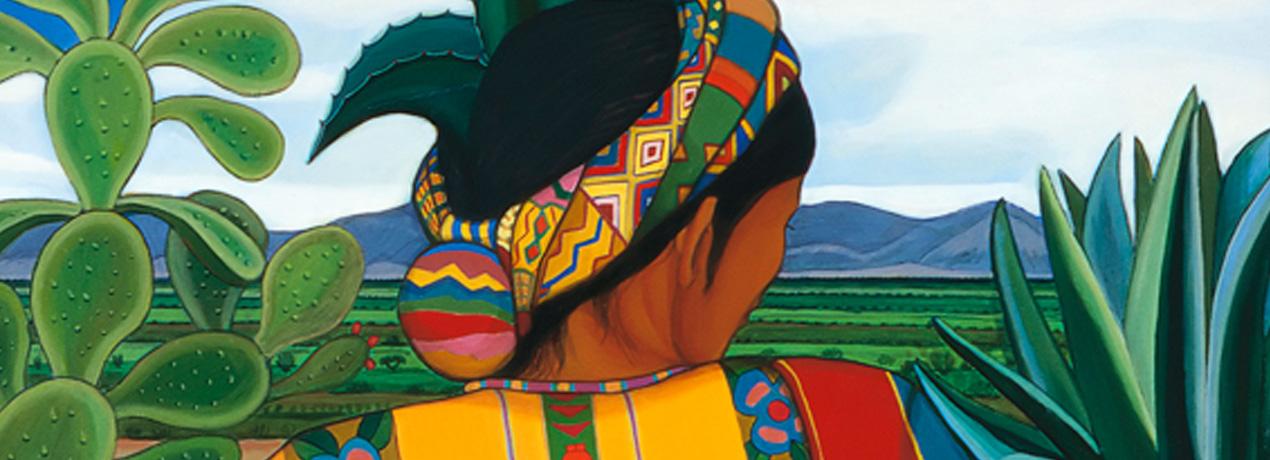La Artista de la frontera: color, mestizaje y chicanismo
Santa Barraza
Exposición 'La artista de la frontera: color, mestizaje y chicanismo', de Santa Barraza.
La muestra es un reflejo de la vida de Santa Barraza, una artista de la frontera. Las obras se impregnan de figuras e iconos que expresan la ideología política feminista. Un mundo de colores brillantes reflejo de la vida del Suroeste de los Estados Unidos y de la vida de las fronteras.
Santa Barraza describe su obra de la siguiente forma: “Esta tierra árida y plana, donde están enterrados los restos de mis antepasados y que forman parte del polvo que respiro, me fuerzan a ser creativa. Mi visión viene de la tierra suspendida en el tiempo. Viene de mirar la línea del horizonte del sur de Texas y de observar cómo se funde el cielo en el infinito. Esta perspectiva inspira mi creatividad y me lleva a la pregunta de lo desconocido, de reflexionar sobre lo inconsciente. La creación viene de esta fuente, de la tierra, nuestra madre.”
Las mujeres de la frontera también han influido en la obra de la artista. Su tatarabuela Karankawa Cuca Giza, que se casó con un conquistador español, y que representa para la artista a la Malinche, la traductora de Hernán Cortés. Canuta Vela Garza, su bisabuela, transformada en la obra como la soldado de la Revolución Mexicana, ya que también luchó contra las injusticias de la Texas colonial y el 1800. Por último, su madre Frances prevalece como la Guadalupana. Bendecida por estas fuerzas, trae su legado creando su propio Popol Vuh (el sagrado Quiche Mayan leyenda de la creación del mundo), un viaje visual de autodescubrimiento e identidad".
Fecha: del 25 de junio al 9 de julio de 2014.
Lugar: galería Guayasamín.
Hora: De lunes a viernes de 11.00 a 19.30.
Sábado de 11.00 a 15.00.
Domingos cerrado.
Entrada libre hasta completar aforo.


Biografía oficial en inglés
Santa Barraza, a native of Kingsville, Texas, is a contemporary Chicana/Tejana artist and educator who received her Bachelor’s of Fine Arts in 1975 and Master’s of Fine Arts in 1982 from the University of Texas at Austin. She is currently a Professor of Art at Texas A&M University in Kingsville, but formerly taught at La Roche College in Pittsburgh, Penn State University in University Park, and the School of the Art Institute of Chicago.
Her vitae reflects a career replete with awards, appearances, and lectures, exhibitions, and publications. She has exhibited widely in the United States, and abroad in Mexico, Argentina, Germany, Spain, and Italy. In 1975 the artist co-founded Mujeres Artistas del Suroeste (Women Artists of the Southwest), one of the first Latina visual arts organizations in Austin and the state. It remained active for a decade, serving the needs of Chicana/Latina visual artists. One of the organization’s major projects featured an international visual arts conference, Conferencia Plastica Chicana/1979, that promoted the scholarship and creativity of Chicano/a and Mexican artists. Some of the featured artists and scholars were Manuel Alvarez Bravo, Adolfo Mexica, Raquel Tibol, Judy Baca, Pedro Meyer, Shifra Goldman, Carmen Lomas Garza, among others. In 1980 she opened Diseno Studios, one of the first Chicano galleries in east Austin, Texas.
In 2001 Texas A&M University Press published Santa Barraza: Artist of the Borderlands which received the 2002 Southwest Book Award from the Border Regional Library Association. She has received many awards, including the 1993 Reader’s Digest/Lila Wallace Grant, 2005 Texas A&M University and Alumni Association Distinguished Research Award, 2007 Division of Student Affairs Texas A&M University Faculty Award, 2008 Women’s Caucus for the Arts Presidential Award for Mid Career Achievement, 2008 Heroes for Children Award by the State of Texas Board of Education, 2012 Suenos, Cultura y Vida Recipient Award by LULAC of Corpus Christi, Texas. Her oral interview of 2003 by Cary Cordova is included in the Interviews of Latino Art Community in Texas by the Oral History Archives of the American Art of the Smithsonian Institution. In 2012 her artwork was selected by the Bullock State History Museum in Austin for the exhibition, “Women Shaping Texas,” in recognition of her contribution to Texas history in the 20th century.
Santa Barraza’s artwork is in the permanent collections of the Museum of Texas Tech University, Mexican Museum in San Francisco, Del Mar College, Fondo del Sol Museum, South Texas Museum, Olin Museum at Bates College, the Hispanic/Latino Archives of the Tomas Ybarra Fausto Collection at the Smithsonian Institution at Washington DC, and other collections and various art collectors. Her artwork has been exhibited in the Mexican Fine Arts Center Museum in Chicago, Austin Arts Museum, Albuquerque Museum, San Francisco Museum of Modern Art, Bronx Museum, Wright Art Gallery in Los Angeles, Intar Latin American Gallery in New York City, Kohler Art Museum in Soboygen, Wisconsin, National Gallery of American Art of the Smithsonian, Los Angeles County Museum of Art, Modern Museum of Art in Mexico City, Santo Domingo Museum of Art in Oaxaca, Mexico, Centro Cultural de la Villa in Madrid, Spain, University of Beliefeld, Germany, among others.
Her artwork has been published in many other publications, including the Latinas in the United States: An Historical Encyclopedia published by Indiana Press University and Laura Perez’s book on Chicana Art: Politics, Spirituality, and Altares published in 2007. Her artwork is also included in the 2008 David Carrasco’s essay for the Aztec World published by Harry Abrams, and 2014 Entre Guadalupe y Malinche: Tejanas in Literature and Art, edited by Norma Cantu and Inez Hernandez Avila, published by the University of Texas Press.
Barraza’s artwork reflects the experience of memory, heritage, identity, culture, family, gender, and the land. Her work includes the public art of murals, paintings, fine art graphic prints, and drawings. She appropriates Mesoamerican iconography and reinterprets it into art forms incorporating the value of Mexican artistic traditions to nurture and sustain cultural and gender identity of a Chicana (Mexican American) in the borderlands of Texas. The artist paints bold representations of Nepantla, the land between. Her work depicts the historical, emotional, and spiritual land between Mexico and Texas, between the real and celestial, between present reality and the mythic world of the ancient Aztecs and Mayas.
Maria Herrera-Sobek, editor of her book, Santa Barraza: Artist of the Borderlands, describes her artwork as “impregnated with mythic figures and icons expressing a feminist political ideology.” She further states that “these political convictions are conveyed through a brightly colored world indicative of a life lived amid the splendors of the Southwest flora and fauna.”
The artist best describes her passion for creating art by expressing gratitude to the tonal (spirit) of the harsh, arid and flat land of the Borderlands as her teacher and inspiration to produce. She states in her autobiography of her book the following.
“This land, this arid, flat terrain, where the remains of my ancestors are ritualistically buried and have become part of the dust I breathe, forces me to be creative with my vision….My artistic vision comes from this timeless land. It comes from looking at the south Texas horizon line and observing the land melting into the sky- the two merging together into infinity. I am entranced by the combination of these opposing forces- the earth and the sky, the physical and the immaterial ethereal, blending and becoming one. This perspective inspires creativity and moves me to question why-to question the unknown, to ponder the unconscious. The creative forces come forth from this source, from this land, our mother.”
At the finale of her autobiography in her book, Santa Barraza states the following:
“Twenty-five years ago, I left my birthplace seeking knowledge to enrich myself as a person and an artist. I traveled to the Northeast, Midwest, West, and even Mexico, only to discover that the answers to my questions were not there. Ironically, I discovered that the information I sought always had been at my immediate disposal, in my own family, home, and town. Unfortunately, my mother has already passed away, and I have returned to a home devoid of that warmth and charm that only a mother can create. Nevertheless, the strength, memories, history, and folklore that she imparted to me continue to animate me. They are reflected in my artwork and continue to energize my figures and symbols, as they narrate their stories. These images recontextualize themselves as incarnations of the forces of nature and humanity in a desolate territory. I think about the strength of those indomitable women who lived in the harsh environment of the Borderlands. My Karankawa great-great-grandmother Cuca Giza, who married her Spanish conqueror, has become my Malinche, mistress of Hernan Cortez. Canuta Vela Garza, my great grandmother, has been transformed into my soldadera of the Mexican Revolution, as she fought against injustices and forged an existence in colonial Texas in the 1800s. My mother Frances prevails as my Guadalupana. I feel grateful that I was able to respond to these diverse forces by carrying on the legacy of perception and by creating my own Popol Vuh (the sacred, ancient Quiche Mayan legend of the creation of the world and humanity), a visual journey of self-discovery and identity. This gift of vision I now am able to share with my people and with anyone willing to listen to my story of reclamation. The sharing, after all, is indispensable for my survival and my existence.”





